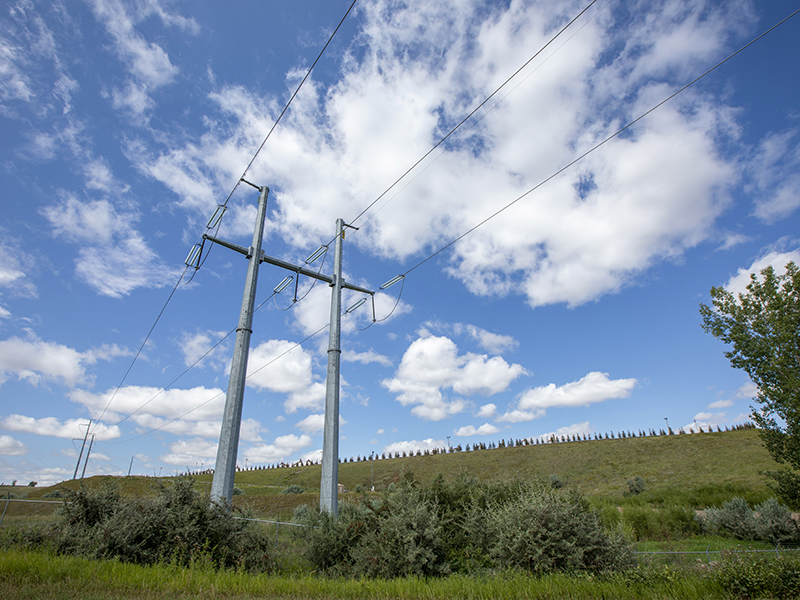- Products
- About us
- Responsibility
- Environment
- News
- Contact us
- Careers
-
The first thing that might come to mind when you hear the word congestion is not being able to breathe due to springtime allergies or the common cold. Roadways can also be congested during a traffic jam when too many cars are plugging up the road or construction forces you to take an alternate route.
The concept is similar when referring to congestion in the energy industry – it’s the lack of ability to move power freely on the transmission system. “Simply put, congestion is the result of limited transmission,” says Alycia Kramer, Basin Electric supervisor of market analytics and strategy. “As more generation and load gets added to the power grid, the transmission system is running out of spare capacity, creating congestion.”
While congestion has always been present on the transmission grid, it has become increasingly problematic over the past five to 10 years as additional generation and load have come online. The buildout of wind and other generation projects, along with the addition of load, has been using up the existing margin on the grid. Insufficient transmission has been added as more generation and load is added to move the electricity generated to where it needs to go.

One example of “positive congestion” in Basin Electric’s service area is the Bakken region in North Dakota. “The Bakken is a high load area that is transmission-constrained,” says Valerie Weigel, Basin Electric vice president of Asset Management and Commodity Strategy. “This leads to increased market prices for our generation and load in that area. The increased prices provide an incentive for extra generation to be produced in this area.”
On the flip side, Weigel says we typically see “negative congestion” in the area of Laramie River Station, a coal-based generation facility near Wheatland, Wyoming. “This area is also transmission-constrained and does not have enough transmission to move out all the generation,” she says. “The negative congestion provides lower prices to the generation and load in the area that incentivizes generation to back down in this area to maintain system operating limits.”
According to an April 14 article in the industry publication Utility Dive, a report by the consulting firm Grid Strategies reported that costs to consumers from congestion on the U.S. power grid more than doubled to an estimated $13.3 billion in 2021 from the year before and will likely keep rising until transmission capacity is built.
Jeremy Severson, Basin Electric vice president of Transmission, says the cooperative is doing its part to help fix the problem and is on track to energize nearly 350 miles of high-voltage transmission line in western North Dakota by the end of 2027. The projects, summarized below, are being constructed to address concerns with future reliability, additional load service, and alleviation of economic congestion.
“The two projects in the Bakken region (Roundup-to-Kummer Ridge and Leland Olds Station-to-Tande) are aimed at maintaining reliability as well as allowing the market to economically dispatch generation,” Severson says. “These lines will maintain and improve reliability for the load in the region as well as allow additional margin on the transmission system. That extra capacity will raise the system’s operating limits in the region and clear up the existing congestion issues we see in the market. More transmission capacity equates to less congestion, allowing for the economic dispatch of market generation to serve our membership.”
In its work to combat congestion in its system, Southwest Power Pool (SPP) is considering several recommendations regarding its congestion hedging process, some of which could have negative impacts to Basin Electric. “There is potential that we would not continue to receive the same value from our allocations as we have in the past, so we have communicated that we are not supportive of the market-related changes to SPP’s Congestion Hedging Construct,” Weigel says. “We have also shared our views and advocated our position with various SPP working groups and the North Dakota Public Service Commission.” Basin Electric has voting members on 17 of SPP’s 24 working groups. Weigel, Severson, and Kramer are among the cooperative’s voting members.
With Basin Electric’s most recent load forecast projecting growth over the next 10 years and the clean energy transition in full swing, transmission is key to providing reliable, affordable, and responsible electricity to the people and businesses who will use it. Basin Electric has invested $1.3 billion in high-voltage transmission and will invest another $620 million in the next five years. That nearly $2 billion commitment to high-voltage transmission is nothing to sneeze at – it demonstrates the cooperative family’s dedication to its members and rural America.
Following is a list of the transmission projects recently completed and underway at Basin Electric.
Neset-to-Northshore
230-kilovolt, 27-mile transmission line to be energized in January 2023
Pioneer Generation Station-to-Judson
345-kilovolt, 15-mile transmission line to be energized in 2024
Springbrook
345/115-kilovolt substation. Includes new delivery point for Mountrail-Williams Electric Cooperative, to be energized in 2025
Roundup-to-Kummer Ridge
345-kilovolt, 35-mile transmission line to be energized in 2025
Leland Olds Station-to-Tande
345-kilovolt, 175-mile transmission line and new 345/115-kilovolt substation to be energized in 2026
Wheelock-to-Saskatchewan
Tande-to-Saskatchewan
230-kilovolt transmission lines, 50 to 60 miles each to be energized in 2027
Dakota Gasification Company
Headquarters:
1717 East Interstate Avenue | Bismarck, ND 58503-0564 USA
701.223.0441 | 1.800.242.2372
Great Plains Synfuels Plant
420 County Road 26
Beulah, ND 58523-9400 USA
701-873-2100
A subsidiary of:
Basin Electric wants all interested and qualified candidates to apply for employment opportunities. If you are an applicant with a disability who is unable to use our online tools to search and apply for jobs, or who needs other assistance or accommodations, please contact us at 701-223-0441. Please indicate the specifics of the assistance needed or provide your contact information, and a Basin Electric Human Resources representative will contact you. Basin Electric is an Equal Employment Opportunity Employer regarding race, color, religion, sex, sexual orientation, gender identity, national origin, disability, and veterans status.